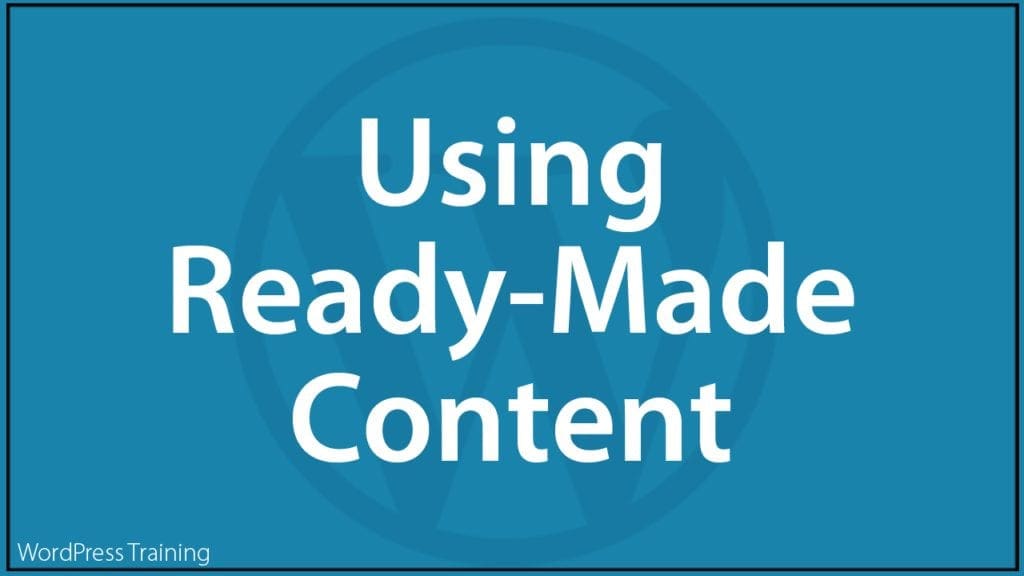Content Marketing With WordPress – Using Ready-Made Content

This tutorial is part of our series on using content marketing to create more exposure online for your business and drive more traffic to your site.
Subscribe to our web content creation course and learn how to never run out of great content for your website, blog, or newsletter.
***
This section of our tutorial series on content marketing covers different methods you can use to create content for your site using third-party content.
In this tutorial, we look at using ready-made content.
We also recommend the tutorials below for additional information:
- Rewriting Content
- Using Content Writing Tools
- Using Content Rewriting Tools
- Using Ready-Made Content (this tutorial)
Using Ready-Made Content
In addition to writing original or unique content, or gathering information by scouring the web and rewriting existing content, you can also purchase ready-made content that you then publish as is, or rewrite and publish as your own.
This type of content is called Private Label Rights content, or “PLR” content.
PLR article services leverage group buying power by hiring writers to create content and then selling a limited (or unlimited) number of this same content to users.
Some PLR services sell content as a membership (e.g. monthly articles), and some let you select and add items (e.g. an editable report) to a shopping cart.
PLR generally gives you the right to do things like edit, reformat, repurpose, and publish the content with your name as the author.
PLR can be useful for things like:
- Article outlines.
- Content snippets or tips for your blog or newsletter.
- Lead generation reports.
- Bonuses, etc.
Typically, PLR vendors will provide you with a list of what you can and can’t do with the content (i.e. your usage rights).
Although you can publish PLR content “as is” on your site, it’s best (and strongly recommended) to edit or rewrite PLR articles and make these unique, as everyone else buying the same PLR content will also own the exact same copy of the content.
![]()
For a more in-depth tutorial about using PLR content, go here: Using Private Label Rights (PLR) Content
Repurposing Existing Content
Repurposing content means taking existing information and turning it into something new that you can then publish in different formats and/or media types.

Here are just some content repurposing strategies you can experiment with:
- Update older blog posts with new information and adding graphics images to text-only content.
- Create infographics from existing blog posts and articles and post these on sites like Pinterest.
- Rewrite or create excerpts or summaries from your blog posts and articles and post these on social media sites like Facebook or LinkedIn.
- Turn your written content into audio transcripts with realistic AI voices using text-to-speech software.
- Turn your blog articles into PDF reports and slide presentations and publish these on sites like SlideShare.com.
- Turn your slide presentations into video sales letters and publish these on video-sharing sites (YouTube.com, Vimeo, etc.)
- Create podcasts from existing blog posts and articles and publish these to podcasting sites.
- Compile existing blog posts and articles into ebooks, or training content for membership sites, e-courses, etc.
- Use excerpts from existing blog posts and articles to create email drip campaigns for newsletters or lead generation reports.
Find effective content repurposing methods that work for you and incorporate these into your content planning and marketing strategy.
For example, here’s an easy and logical process for repurposing existing content into different content formats:
- Create blog posts and articles for your site.
- Turn your blog posts and articles into slide presentations.
- Turn your slide presentations into narrated videos.
- Use a screen capture software (e.g. Camtasia) to extract the audio component from your videos and use these to create audio content for podcasts.
- Compile all of the above into content for newsletters, e-courses, lead generation reports, etc.
Here’s the content repurposing formula for the above:
Blog Posts > Slide Presentations > Videos > Audios > Other Compiled Content
Repurposing the same content into different formats allows you to increase your online business exposure significantly and drive more traffic to your site using multiple marketing channels.
And it doesn’t have to stop there. If your old posts include unique images (i.e. product images, original memes, etc.) or interesting infographics, you can repurpose and republish these too.
Sourcing Existing Content
If you don’t want to create your own images, there are many places available for purchasing stock images and graphics or even sourcing these for free.
See this tutorial to learn more about sourcing images for your content: Where To Find Free And Royalty-Free Images
Outsourcing Content
Another option for using ready-made content, of course, is to outsource your content writing.
As an outsourced content publisher, you commission a ghostwriter or freelance writer to create and deliver you ready-made content, which you then assume the rights to after payment of services or some other reciprocal agreement.
Even though this outsourced content is created by a third-party, it belongs to you and you can do with it as you please.
![]()
As the topic of outsourcing content creation is beyond the scope of our tutorials, we have created an in-depth course on content creation that you can subscribe to for FREE here: Content Creation Course
Content Repurposing and Outsourcing – FAQs
Here are frequently asked questions about content repurposing and outsourcing:
What is content repurposing, and why is it beneficial for WordPress users in content marketing?
Content repurposing involves transforming existing content into different formats (e.g., blog posts into videos or infographics). It’s advantageous for WordPress users as it extends content reach, maximizes ROI, and enhances audience engagement through diverse content types.
What are the advantages of content repurposing for WordPress SEO?
Repurposing content allows WordPress users to target different audience segments and platforms, improving SEO by increasing backlinks, social shares, and overall visibility. Additionally, it helps maintain consistency across various channels.
What are the potential drawbacks or challenges of content repurposing for WordPress users?
Despite its benefits, content repurposing can be time-consuming and requires careful planning to ensure content coherence and relevance across different formats. Over-replicating content without adding value may also dilute brand messaging.
Why do businesses consider outsourcing content writing, and what are the benefits?
Businesses outsource content writing to access specialized skills, save time, and scale content production cost-effectively. Outsourcing allows them to tap into a global talent pool, ensuring high-quality content creation tailored to their needs.
What are the potential drawbacks of outsourcing content writing for businesses?
Outsourcing may lead to loss of control over content quality and brand voice, especially if communication with freelancers or agencies is inadequate. Additionally, reliance on external parties can pose risks of missed deadlines or confidentiality breaches.
How can WordPress users mitigate the challenges of outsourcing content writing?
WordPress users can mitigate outsourcing challenges by establishing clear communication channels, providing detailed guidelines, and thoroughly vetting potential content partners. Regular feedback and quality assurance processes are essential for maintaining content standards.
***
Hopefully, now you have a better understanding of some of the ways you can source content for your website or blog from third-party sources.
For additional tutorials on ways to create content for your website, go here: Content Marketing With WordPress

***
Updated: July 5th, 2024

